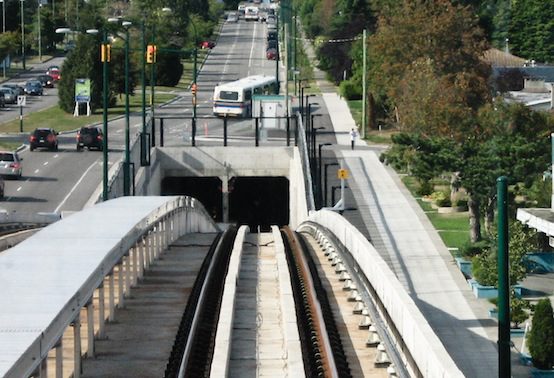Transit Gives Millennials an Off-Ramp From Cars

For generations of young Americans, a driver’s license stood as the ticket to freedom, freeing teenagers from the watchful parental eyes that accompanied being dropped off at bowling alleys, bookstores, and boyfriends’ houses. Living in a sprawling, vast country, particularly one whose postwar planning consensus had been dedicated to subsidizing suburban sprawl, a car was often the only feasible way to connect their geographically disparate destinations. Recent years, however, have seen millennials deserting the car in startling numbers. While the drop is certainly driven in part by the economic pinch of soaring gas prices and the increasing burden of graduated license regimes, an accompanying trend has given young would-be drivers a transportation off-ramp that preserves their mobility: the revival of transit.
One of the latest and clearest examples of transit’s poaching of the young comes from just north of the border, where the Vancouver metro region has seen the percentage of residents aged 20-24 even possessing a drivers license to have dropped from 70 percent 2004 to 55 percent last year. As Kenneth Chan describes the data,
The greatest declines were seen in the municipalities that are the most urbanized and served by a substantial level of public transit. …
Burnaby and New Westminster’s proportion declined from 68 per cent to 50 per cent, likely due in part to the increased accessibility to transit following the construction of the Millennium Line.
Richmond also saw a similar drop of nearly 20 per cent from 2003. Metro Vancouver’s data shows that the biggest year-to-year drop for both Vancouver and Richmond was in 2009 when the Canada Line opened for service.
While driver’s license data likely wouldn’t reflect changes in older cohorts that had already procured licenses (indeed, those were mostly flat, even increasing among the over-65), the Vancouver’s aggressive push to increase the accessibility of transit in its region has clearly started to capture the rising generations.
The trend is well-documented below the 49th parallel, as well. Last year Brad Plumer over at the Washington Post noted that the average yearly miles driven by 16- to 34-year-olds fell 23 percent between 2001 and 2009. Over that same period, public transportation use per capita rose 40 percent, and bicycling rose 24 percent.
While these data sets do certainly overlap with significant economic pressures that could be depressing the results, transit has started to shake off any perceptions of it as the poor person’s transportation of last resort. As Amy Crawford describes at Atlantic Cities, transit has become so popular in many places that the announcement of new transit extensions will drive up nearby real estate prices, and neighborhoods with newly-installed transit saw people with incomes over $100,000 disproportionately flock to them. And while the youth migration to cities may have once been seen as a luxury of unattached twenty-somethings who would once again return to the suburbs when it came time to settle down and nest, the New York Times recently reported that even stalwart suburbs like those of New York’s Westchester County were starting to get anxious at the failure of younger adults to boomerang back out to the ‘burbs.
While the exact numbers will continue to shake out, the trend seems reasonably clear: once famously sprawl-friendly Americans are flocking to dense communities, and are willing to ride the rails to get there.
Comments